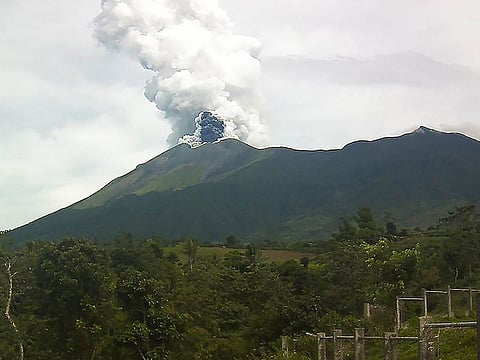Pilots urged: Avoid flying near restive Philippine volcano
Mt. Kanlaon records 17 volcanic earthquakes in the last 24 hours

Manila: Pilots had been advised to avoid flying near a Philippine volcano’s crater as the restive Mount Kanlaon is expected to spew out steam anytime.
Mt. Kanlaon, which straddles the central Philippine provinces of Negros Occidental and Negros Oriental, has recorded 17 volcanic earthquakes in the last 24 hours, with possible phreatic explosion anytime, volcanologists said Saturday.
The volcano, located about 36 km southeast of the capital city of Bacolod and most populous city of Negros Occidental, has been emitting a plume of smoke up to 300-metre high towards north-east.
An alert bulletin issued Saturday (September 10, 2022) by the Philippine Institute of Volcanology and Seismology (Phivolcs), urged people not to enter a 4-km radius permanent danger zone around Kanlaon.
On August 30, 2022, the volcano has also expelled more than 196 tonnes of sulfur dioxide flux.
Kanlaon volcano (also spelled Canlaon) is one of the active volcanoes in the Philippines and part of the Pacific Ring of Fire. It forms the highest peak of Negros Island and is located west of Kanlaon, about 36 km southeast of capital Bacolod City and belongs to Kanlaon National Park.
Volcanoes and earthquakes
The Philippine islands form part of the so called “ring of fire”, where many of Earth's volcanic eruptions and earthquakes occur. The country has more than 300 volcanoes, of which 24 are active, according to Philvolcs.
Volcanoes and earthquakes occur due to movement of the Earth's tectonic plates. Hundreds of earthquakes are recorded in the country each day. Some can be occasionally strong.
Volcano Discovery, which keeps tracks of earthquakes, recorded an average of 28 earthquakes per day from January 7 to February 7, 2021.
Most quakes occur along cracks in the planet's surface, of which up to 90% happen within in this "ring". This massive area is known for its many fractures (small and localised or thousands of miles long) where the Earth's tectonic plates meet.
Sign up for the Daily Briefing
Get the latest news and updates straight to your inbox



